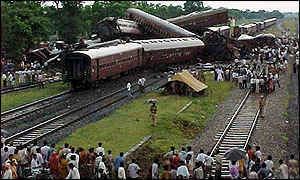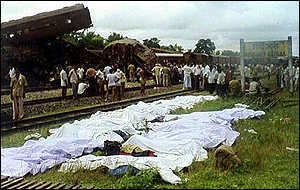Injuries More than 300 Dates 2 Aug 1999 – 1 Aug 1999 | Location Guwahati Total number of deaths 285 Trains 2 | |
 | ||
Similar Bihar train derailment, 1999 Bourbonnais - Illinois - tr, Saint‑Michel‑de‑Maurienne derailment, Balvano train disaster, Rafiganj train wreck | ||
The Gaisal train disaster occurred on 2 August 1999, when two trains carrying 2,500 people collided at the remote station of Gaisal, 310 miles from the city of Guwahati in Assam. The crash was at such high speeds that the trains exploded upon impact killing at least 290 people.
Contents
Collision
The crash occurred at about 1.30am on 2 August, when the Avadh Assam Express from New Delhi was stationary at the station. The Brahmaputra Mail from Dibrugarh, packed with soldiers and security police heading for the border regions at very high speed, through a signalling error, was transferred onto the same track as the express train. Nobody noticed the error on either train, or in the signals and station master's office, until the Brahmaputra Mail train crashed headlong into the front of the Avadh Assam Express. The engine of the Avadh Assam was thrown high in the air, and passengers from both trains were blown into neighbouring buildings and fields by the force of the explosion.
Failures
Three of the four lines at Kishanganj station were non-operational since doubling of lines was in progress. Only one line was being used to carry the load usually carried by four - 31 trains in a day. Track circuiting and interlocking were also not working at the station because of the work in progress. Track circuiting is an electrical procedure by which the station master and consequently the train driver can know that the track ahead is occupied. The signals will remain red, interlocking the track, which effectively means that the series of signals cannot be turned green unless the station master allows. The signals can be changed from the relay room which can only be opened by jointly by the station master and the signal inspector. In such a situation, the points in the track have to be set manually by the "cranking" procedure. A crank handle, available at stations, has to be rotated manually on the orders of the station master for setting the points which are then clamped and locked. The entire process takes around 30 minutes. Assistant Station Master (ASM) of Kishanganj station S P Chandra later admitted to sending the Awadh-Assam Express on the wrong (down) line causing it to collide with the Brahmputra Mail on August 1 first presented by a preliminary inquiry report of Chief Commissioner Railway Safety (CCRS). Right after the incident Chandra absconded and was arrested from Katihar on August 10.
Emergency services

The line was blocked by wreckage, and the Gaisal emergency services were utterly overwhelmed, as fire swept through the ruined vehicles and station buildings, killing many of the injured people trapped in the trains. Many vehicles and aid support services had to undertake the 14-hour drive from Calcutta to reach the site, by which time many of those they could have helped were already dead. Those who were picked up by rescuers were taken to hospitals in Kishanganj and Islampur, which were also overwhelmed by the scale of the disaster.

Heavy rains helped dampen fires the following day, and rescue workers began trying to separate the twelve mangled carriages of the train and identify the bodies contained inside. Many were unrecognizable and never identified.
Death toll

The official death toll released was set at 285 killed and over 300 injured in the crash. Unofficial totals have claimed that over 1000 or even more were killed, including 90 soldiers, the reason for this is that though there were only 72 seats in each of the seven general compartments that were involved in the accident, all of them were crowded way beyond capacity. Moreover, there were many ticketless travellers who were not included in the official count. Because of the nature of the crash and fire, as well as the large number of ticketless people who may have been on the trains, the bodies could not be separately identified. There has also been speculation that explosives carried on the military train may have been the cause of the explosion following the impact, rather than the trains themselves. This has been denied by the Indian military, but has remained a controversial issue.
The station master of Gaisal later committed suicide.
Other Indian rail disasters
This was the worst Indian rail disaster since the Firozabad rail disaster in 1995, and is comparable to the Bihar train disaster of 1981, in which as many as 800 people were reported to have died.
